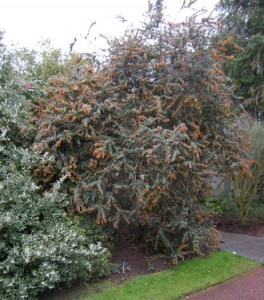If there was ever a plant to deter all comers this is it. The leaves of Berberis darwinii are clothed in lethal spines. Anyone who has cultivated around or weeded beneath the canopy of this plant will have experienced the spines hanging from the flesh of their hands and gathered on clothing during the process. This however did not deter Charles Darwin, who, as naturalist on the voyage of the Beagle discovered the plant in 1835. It was subsequently introduced to Britain by William Lobb in 1849 from Chiloe.
The tri-pointed, dark, glossy evergreen leaves sport a spine at each point of the apex. Other spines are found on the leaf edge. What makes this plant so useful is the prolific flowering and strong evergreen mass that it grows into. It is ideal as a boundary screen or due to the vigorous growth, as a shelter belt plant. Prune flowered growth immediately after flowering before the black fruit has a chance to ripen and shed its fertile seed.
Our plant to the west of the Glasshouses Front Range towers to five metres and has a stabilising root system rarely damaged by wind. A row of these plants will also make a thick, impenetrable hedge.As the golden yellow flowers held on drooping racemes disintegrate the ground beneath becomes a yellow sea of spent flower parts.



Sarah Sells
Hi l’m studying at the Botanics and have this Berberis on a plant ident. Great article, little typo at the end of first paragraph, Chiloe just thought l’d mention it!